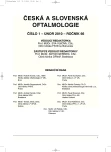The Impact of Implantation of Intraocular Lenses with Negative Spherical Aberration on Contrast Sensitivity
Authors:
M. Ilavská 1; Z. Ilavská 2
Authors‘ workplace:
Očné oddelenie NsP Sv. Lukáša a. s., Galanta, primár MUDr. M. Ilavská
1; Ekonomická Univerzita v Bratislave, Fakulta hospodárskej informatiky, Katedra štatistiky, vedúca katedry doc. Ing. E. Sodomová, Ph. D.
2
Published in:
Čes. a slov. Oftal., 66, 2010, No. 1, p. 15-20
Overview
Aim:
The aim of study was to compare contrast sensitivity (CS) and central visual acuity (CVA) after implantation intraocular lenses (IOL) with negative spherical abberation and spherical IOL at the different light conditions.
Material and methods:
14 patients (28 eyes) were evaluated in the prospective study during period 12/2008 – 01/2009. They have implanted in one eye spherical IOL ( acrylic or PMMA) in past. The hydrophobic IOL Tecnis 1 with negative spherical abberation was implanted to the second eye. The phacoemulsification was done and the IOL was implanted by injector. CVA and CS were evaluated and compared between two eyes at the same patient at the exactly measured light conditions one month after surgery. The digital Multimeter P5025 was used for measurement of light conditions in testing room. The examination of CS was done on Topcon C 100, methods of stimulation with frequency lines and Landolt circles with different contrast. Patients have been evaluated about quality of vision by Visual functioning test VF-14.
Results:
The best corrected CVA was same at the different light conditions on both eye at the same patient. 12 patients have CVA 1.0, and 2 patients have CVA 0.8. Contrast sensitivity was better at the eyes with IOL with negative spherical abberation at the different light condition. The regres statistic analysis was used for statistic evaluation of results, program Statgraphic Plus. The difference between CS tested with lines was significantly better at the eyes with IOL with negative spherical aberration for p < 0.05. Coefficient of correlation r was 0.9835 for photopic conditions, 0.9969 for mesopic and 0.984 for scotopic conditions. Difference at the CS was statistically significant at the examination with Landolt circles too, for p < 0.05. Coefficient of correlation r was 1.00 at the photopic conditions, 0.7385 at mesopic and 0.5415 at scotopic conditions. All the patients indicated improved of vision. VF-14 index was increased.
Conclusion:
We can refer better contrast sensitivity at the different light conditions at eyes with IOL with negative spherical aberration Tecnis1, based on the results of group of 14 patients.
Key words:
intraocular lenses with negative spherical aberration, contrast sensitivity, Visual functioning test –VF-14
Sources
1. Awwad, S.T., Warmerdam, D., Bowman, W., Dwarakanathan, S., Cavanagh, D., McCulley, J.P.: Contrast Sensitivity and Higher Order Aberrations in Eyes Implanted With Acrysof IQ and Acrysof SN60AT Intraocular lenses. J Refract. Surg., 24, 2008: 619–625.
2. Caporossi, A., Martone, G., Casprini, F., Rapisarda, L.: Prospective Randomized Study of Clinical Performance of 3 Aspheric and 2 Spherical Intraocular Lenses in 250 Eyes. J Refract. Surg., 23, 2007: 639–648.
3. Denoyer, A., Denoyer, L., Halfon, J., Majzoub, S., Pisella, P.: Comparative study of aspheric intraocular lenses with negative spherical aberration or no aberration. J Cataract Refract. Surg., 35, 2009: 496–503.
4. El Hage,B: Contribution of crystaline lens to the spherical abberation of the eye. J Ophtal. Sci. AM, 63, 1973: 205–211.
5. Franchini, A.: Compromise between spherical and chromatic aberration and depth of focus in aspheric intraocular lenses. Journal of Cataract & Refractive Surgery, 33(3), 2007: 497–509.
6. Holladay, J.T., Piers, P.A., Koranyi, G., Van der Moren, M., Norrby, N.E.: A new intraocular lens design to reduce spherical aberration of pseudophakic eyes. J Refract. Surg.,18, 2002: 683–691.
7. Jurkovičová, J.: Praktické cvičenia z hygieny I. 2005, Univerzita Komenského, Bratislava, s. 162–170.
8. Linder, M., Chang, T.S., Scott, I.U., Chamber, S. K., Sibley, L. M., Weis, E.: Validity of the Visual Function Index (VF-14) in Patients With Retinal Disease. Arch. Ophthalmol., 117, 1999: 1611–1616.
9. Liška, V.: Citlivost na kontrast. Čes. a slov. Oftal., 54(6), 1996: 3–7.
10. McGrath, D.: Tecnis I-Piece IOL has the edge for PCO resistance, study finds. Eurotimes, 13(12) 2008: 6.
11. Mester, U., Kaymak, H.: Comparison of the AcrySof IQ Aspheric Blue Light Filter and the Acrysof SA60 AT Intraocular lenses. J Refract. Surg., 24, 2008: 817–825.
12. Nixon, D.R.: Cataract Surgery Technology Waves Converge. Eurotimes, supl. September 2008.
13. Pitrová, Š., Obrusníková, E.: Hodnocení kvality života. Čes. a slov. Oftal., 56(5), 2000: 337–342.
14. Steinberg, E.P., Tielsch, J.M., Schein, O.D., Javitt, J.C., Sharkey, P., Cassard, S.D., Legro, M.W., Diener, W.M., Bass, E.B., Damiano, A.M., Steinwachs, S.M., Sommer, A.: The VF-14. An Index of Functional Impairment in Patients With Cataract. Arch. Ophthalmol., 112, 1994: 630–638.
15. Szurman, P., Petermeier, K.: Aspheric IOLs Benefit Quality of Vision. Cataract Refract. Surg., 4(1), 2009: 17–1.
16. Tzelikis, P.F., Akaishi, L., Trindade, F.C., Boteon, J.E.: Spherical aberration and contrast sensitivity in eyes implanted with aspheric and spherical intraocular lenses: a comparative study. American Journal of Ophthalmology. 145(5) 2008: 827–33.
17. Wang, L., Dai, E., Koch, D.: Optical aberrations of the human anterior cornea. J Cataract Refract. Surg., 29, 2003: 1614–1521.
18. Zhao, H., Mainster, M.A.: The effect of chromatic dispersion on pseudophakic optical performance. British Journal of Ophthalmology, 91(9), 2007: 1225-9.
Labels
OphthalmologyArticle was published in
Czech and Slovak Ophthalmology

2010 Issue 1
Most read in this issue
- Our Two – Years Experience with the Bevacizumab (Avastin) Treatment of the Age Related Macular Degeneration Wet Form
- The Influence of the Lens Capsule Mechanical Polishing to the Secondary Cataract Development
- Bacillus Cereus Keratitis – Case Report
- The Impact of Implantation of Intraocular Lenses with Negative Spherical Aberration on Contrast Sensitivity
